| Article ID | Journal | Published Year | Pages | File Type |
|---|---|---|---|---|
| 3284890 | Clinical Gastroenterology and Hepatology | 2008 | 10 Pages |
Background & Aims: Esophageal variceal bleeding has a high mortality rate and requires complex management. High provider volume has been associated with improved outcomes for various surgical procedures and medical diagnoses, and volume-based referral has been advocated. The objective of this study was to assess the volume-outcome relationship in patients with esophageal variceal bleeding. Methods: We analyzed the 1998–2005 Nationwide Inpatient Sample to identify patients hospitalized for esophageal variceal bleeding. The effects of hospital volume on in-hospital mortality, length of stay (LOS), and hospital charges were evaluated by using logistic regression models with adjustment for demographic and clinical factors. Hospital volume was classified on the basis of the average annual number of esophageal variceal bleeding admissions during the study interval (low volume, <13; medium volume, 13–25; and high volume, >25). Results: Between 1998 and 2005, there were 36,807 hospitalizations in 2575 hospitals for esophageal variceal bleeding. The majority of the hospitals were low-volume centers (76%). Overall, in-hospital mortality was 10.9% (95% confidence interval [CI], 10.5%–11.4%), median LOS was 4 days (interquartile range, 2–6), and total per patient charges were $21,144 ($13,240–$36,533). Compared with low-volume centers, admission to a high-volume hospital was associated with an increased risk of death (11.9%; odds ratio, 1.16; 95% CI, 1.03–1.29), prolonged LOS, and increased total charges (P < .005). However, patients admitted to high-volume hospitals were more likely to have negative prognostic characteristics including male gender, non-white race, nonprivate health insurance, alcoholic cirrhosis, hepatic decompensation, and to have been transferred from another institution (P < .05). After adjusting for case mix, volume was not an independent predictor of in-hospital mortality (odds ratio vs low-volume: medium-volume, 0.96; 95% CI, 0.87–1.05; high-volume, 1.03; 95% CI, 0.92–1.15) or LOS; however, medium- and high-volume centers had increased total charges (P < .00005). Conclusions: The volume-outcome relationship observed for some procedures and conditions does not apply to patients with esophageal variceal bleeding. Therefore, volume-based referral is not indicated to improve short-term outcomes in this condition.
